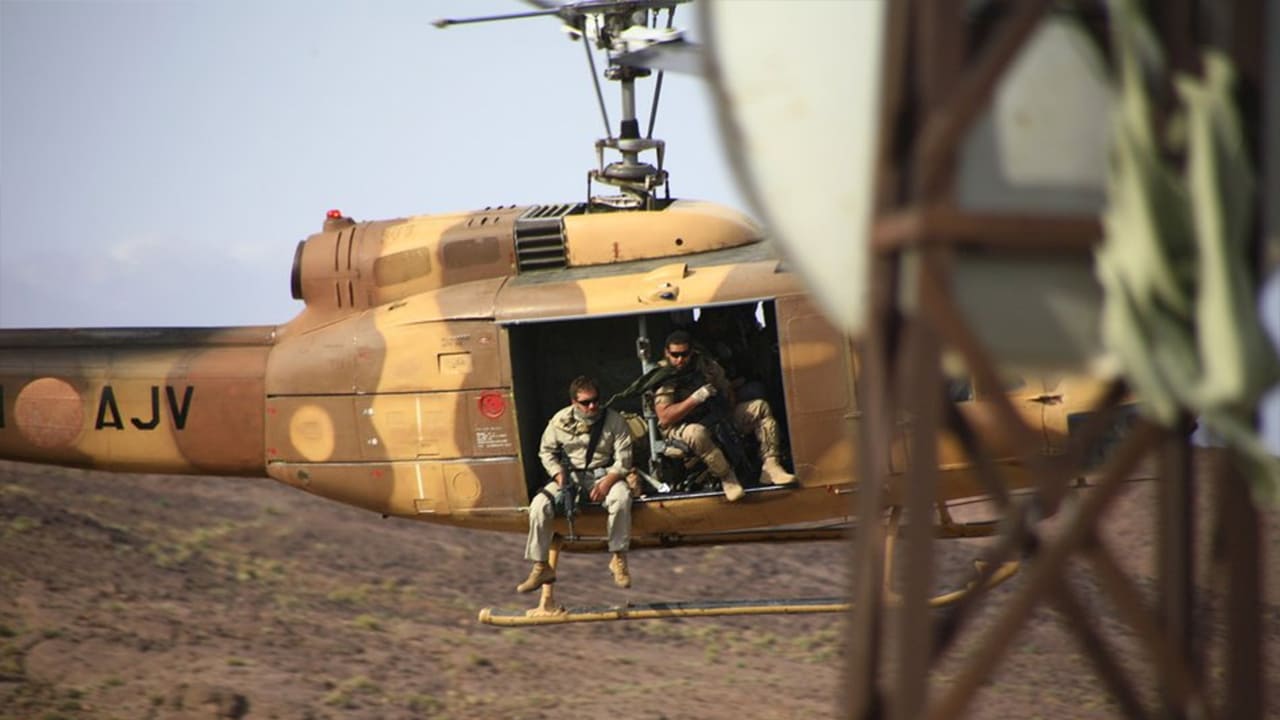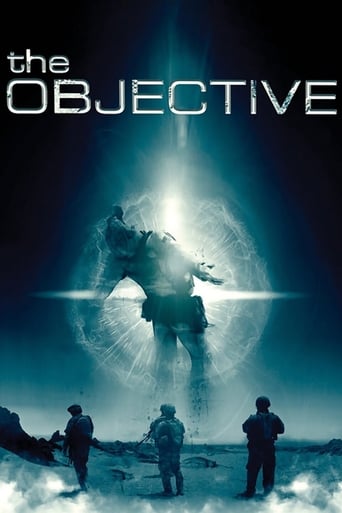

Starts out half-interesting but gets too caught up with it's own inability (or desire) to tell a straight story that it just becomes a jumbled mess.If I was to summarise it it would be that a group of soldiers have an objective to identify something mysterious in the desert of Afghanistan.There's not really any need for spoiler warnings or anything because there's really not a whole lot to spoil as there is not any clear answers to what this movie is about.Now of course as a viewer we are able to form our own picture to what it is about but there really aren't enough interesting characters or events to really warrant expecting the viewers to do that.Acting is fairly amateurish overall, I think the lead guy mainly got the role because he was American and knew how to speak Arabic tbh.Yeah nothing too exciting here, and in the end pretty pointless.
... View MoreFriends ask me this question fairly frequently - especially now that the movie's been back on Netflix. I thought I'd post my analysis, which, for what it's worth, has satisfied most of them... (My background is in Eastern philosophy and mythology, which this movie is primarily about and why I'm asked this question.)(1) The Background (2) The AnalysisFirst question is usually, "What are those balls of fire? Ufos, ghosts, souls?" Short answer is: none of the above. Or at least, not specifically. In order to answer this question, it's necessary to understand what "a Vimana" is and how they function in Indian religion and mythology. (1)Vimanas are, in short, "chariots of the gods." They are typically depicted as peaked royal palanquins or stupas (peaked temples), hence their visual representation as triangles. But they are also occasionally birds, as in the case of Vishnu's mount Garuda, or winged structures.In Hindu mythology, existence consists of seven higher and seven lower heavens or planes of existence. When Indra, leader of the Devas (a group of lesser gods) wants to visit earth he - you guessed it - jumps in to his Vimana and shoots down to our plane of existence. Running through all planes of existence is an endless pillar of fire, lingodbhava-murti, the primal form of Shiva, the creator (that later also includes Vishnu at the bottom and, generally, Brahma at the top). While the pillar is endless in Hinduism, in Buddhism the top of the pillar ends at Brahma until Buddha (or anyone) achieves enlightenment, at which point it becomes endless. The top of the "Brahma pillar" is a triangular structure with Brahma's three faces representing dominion, or arbitration, over the past, present and future (he looks in to or "sees" all-time). The lingodbhava-murti, then, is both endless (spaceless) and timeless or "out of time."But what does all of this have to do with the movie?(2)So, Keynes and his team are off searching for Vimanas in the desert. And they find them: the arrival of Vimanas signified by helicopter sounds ("birds" - see above), triangular structures, and the small metal airplane (a chariot with wings). But why is the metal airplane first discarded in the dirt by the oasis and later clutched in Keynes' hand at the end?Specifically, Keynes achieves a form of enlightenment as indicated by the touch on his forehead at his third eye (a common association), his levitation (another common trope), his "open eyes" in the medical suite, and his entrance into - or acceptance by - the Vimana. At this point he has moved outside of our specific plane and is traveling throughout existence. He too "sees all."There are also, I believe, references to quantum mechanics and string or multiverse theory at this point - specifically with regards to the flares. Waveform collapse, in quantum mechanics, refers to when an infinite number of possibilities, or potentialities, collapse (mathematically) in to a decision point or "singularity." (Interestingly, both waveforms and strings are often described as "vibrating" and waves - after all - DO vibrate; another sly association, I think, with his vibrating hand.) In certain forms of multiverse theory these decision points do not cancel out other potentialities (as in QM) but birth additional universes in which they did occur: a universe in which you went left instead of right, called your mother back instead of ignored her, liked peanut butter instead of hating it, etc, ad infinitum.The flares, then, are all from Keynes. As Keynes begins to "enter" the Vimana and transcend - or move out of - fixed existence he/we begin to see his entire waveform - if you will - or his mutiverse of singularities. We see flares that he might have sent up or did in another space/time-line... past, present and future. Simultaneously. There are also reasons to believe that his wife is actually dead during the timeline we observe in the film (from earlier dialogue, his weeping over his wife's picture, references to why he took the mission in the first place knowing it was suicidal (nothing to live for)). Yet she's alive at the end credits giving an interview? And the plane is both in his hand and back at the oasis... Notice, too, that the final ascentional montage contains formulas from Einstein's relativity theorem (on Space-Time) and what appears to be the head of Brahma, among other symbology. Neat!Finally, why is Keynes apparently "saved" or "enlightened" when everyone else gets blown away? On somewhat shaky ground here, but I think, possibly, that he is meant to be seen as at least seeking enlightenment, attempting to "see farther," while the rest of the group do not. This evidenced, mainly, by his camera... Of the large, monocular variety, as you recall: literally "a third eye." The only other group member to individually see the other "travelers" dies after having seen them through his BINOCULAR night vision goggles (and killing the guardian/ascetic/enlightened old guy).As far as production goes, I agree with most other reviewers: it certainly could have benefited from a larger budget. But it worked for me and I'm a fan of deliberate, well-done low-budget sci-fi (as well as the other kind).If you'd like more of this, I recommend Shane Carruth's two fantastic movies: "Primer" and "Upstream Color." Also can't say enough about "Valhalla Rising," another great "film of ideas." Bone up on your Dante, Apocrypha (Dismas/The Harrowing of Hell) and Norse mythology to enjoy that one though... But if you do, it's fantastic.For what it's worth, I have no connection whatsoever to anyone involved in the production of these films...Best, Chris.
... View MoreAfghanistan November 2001 and the Taliban who have ruled the country under a jackboot for several years have been ousted . A CIA operative is embedded with an American special forces team and leads them on a secret mission in the South of the country . After a fire fight with the Taliban where several insurgents are killed the SF team are puzzled in finding the bodies of the dead have disappeared , almost as if they'd never existed I've got to put my hand up and say I knew this was a cross genre movie before I watched it . If you're expecting a straight laced action thriller set in the 'Stan then you might be surprised as to where this is heading . Director Daniel Myrick does play up to the film being set in a very real time and place , giving the movie an almost documentary look with hand-held cameras and cinema verite style but this isn't how the film progressesForeshadowing is a difficult thing . Play your hand too soon and the audience might be one step ahead of the characters and boredom sets in , play it too late and the audience will feel cheated so the writers deserve some credit in keeping the audience intrigued . I did have a rough idea where everything was heading and was still interested , though wasn't entirely gripped . Some credit too for bringing in a little bit of past history to Afghanistan involving Alexander The Great's ill fated expedition to the country and the reference of the British retreat from Kabul in the 19th Century . A graveyard of empires indeed Everything's chugging along nicely and THE OBJECTIVE is a engaging little horror/war film with some good locations and a small non star cast . The problem lies in the last five minutes which I had difficulty in understanding . Again it's not down too much or too little foreshadowing but the fact it remains unexplained which diluted my enjoyment of the film slightly which I was enjoying up to this point
... View MoreIt's understandable this was in the science fiction section of Bluckbuster. It has unexplained phenomena that characters are subjective to, something often capable of unsettling people. Howevr, here its played for mystery value, as often there were scenes that didn't feel like the audience was supposed to get scared.The characters were, aside from the character of Abdul, not terribly indistinguishable. The protagonist was mainly separate from the others by being from the Government rather than the military, but besides being more aware of the phenomena he was quite bland. The chief officer was mainly distinguishable from the others only because he provided conflict with the protagonist.The others - one died quickly, one became sick, and, honestly, that's the closest to characterisation I remember them getting.Despite this, its quite interesting and, despite early resemblance to "Death Watch" and "Outpost", its a different film.
... View More